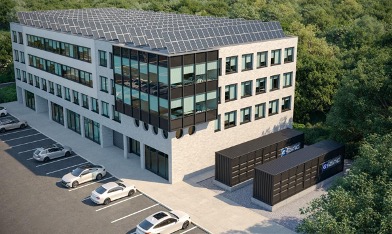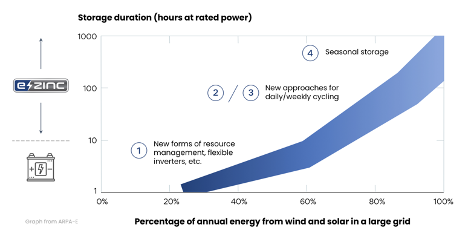Energy Resilience Easy as A-B-Z
Energy storage can be a challenge in the transition to renewable energy. James Larsen of e-Zinc explains how their novel zinc battery is solving for reliable, long duration, fossil fuel free backup power. It is also a paradigm shift in energy storage to enable a zero-carbon energy future.
Grid-tied energy supply disruptions are on the rise as climate impacts grow. For facility owners and operators, a source of reliable back-up power is essential. Customers who have high reliability needs – data centres, hospitals, telecom, and the like – require multiple days of resiliency.
Multi-day solutions from the past are fossil fuel burning systems like gas or diesel generators, which are inflexible, polluting, loud, and a pain to operate. Moreover, commercially available batteries are limited in their ability to provide longer duration power.
What if there was an energy resilience solution that was reliable, safe, clean, quiet, and economical?
Toronto-based company e-Zinc is solving for this challenge. We have developed a breakthrough electrochemical technology for storing energy on site through zinc-based battery systems. The system uses zinc metal as the energy carrier, providing high energy density at lower cost. Our novel solution offers flexible, long-duration energy storage that meets today’s low carbon, dispatch-able power needs.
e-Zinc’s technology can provide an affordable and reliable source of backup power for 1 to 2 days or longer in the case of grid outages, brownouts, or Public Safety Power Shutoffs (PSPS). Its multi-day duration is a significant increase over the few hours of power supplied by commercially available batteries, bringing assurance to business owners that their operations’ energy needs can be met.
The power supply is quiet and pollution free, diametrically opposite to noisy fossil fuel generators that contaminate local air quality and pose significant health risks. Also, as the technology inherently has no risk of fire, explosion, or thermal runaway, it is a lower risk option particularly in fire prone areas.
By discharging during peak periods, e-Zinc’s energy storage system can also offset electricity otherwise supplied by fossil-fuel utility peaking units, even when the risk of grid disruption is low.
How it works
The foundation of e-Zinc’s technology is an electrochemical cell which consists of a charging section at the top, a discharging section at bottom, and a storage section in the middle. To store energy, zinc metal precipitates out of solution onto deposition sites on the electrodes in the charging section, which is periodically wiped off from the charging electrodes, allowing the metal to fall naturally through the electrolyte onto the discharging electrodes. When discharging, air is injected into the cell and the oxygen dissolves the zinc back into the electrolyte, which is then recirculated to the charging section, ready for the next charging cycle.

What resilience looks like at building scale
For each building owner/operator looking for back-up power, e-Zinc would design a stand-alone, fully contained DC system that meets the power and energy needs of their specific market application. In this application, the system sits behind-the-meter and is grid-connected (and can be connected to solar, if available) in order to power the facility. The system is also designed to be flexible to scale in the future.
e-Zinc systems will be pre-packaged in shipping or storage containers. They will be pre-assembled and tested for quality control at e-Zinc’s manufacturing facility, before being shipped to and installed at the building site. The storage solution is designed to provide a fully integrated and packaged DC system, including the electrical drive train, Balance of System (BOS), and Battery Management System (BMS) to integrate with building management systems that control and monitor a building’s electrical equipment such as ventilation, lighting, energy, fire systems, and security systems.
e-Zinc will provide a turn-key long term energy storage solution and has channel partners (EPCs, system integrators, and/or project developers) in place to prepare the site for landing and commissioning our energy storage solution, and to work with local utilities when needed to perform the grid interconnection.

The economic case
e-Zinc’s solution doesn’t simply improve resilience in the case of energy disruptions. It solves multiple economic challenges as well.
First, the materials used are less expensive. By storing electrical energy within zinc metal, the system can store hundreds of hours of energy capacity while being significantly cheaper than other battery technologies. And donning a circularity lens, almost every component has an existing recycling market or can be reused in subsequent systems.
In terms of operating costs, once on site, the technology has little or no reliance on cooling or heating systems, which saves on upfront capital cost and avoids parasitic load during operation.
Most importantly, consider energy bill management. e-Zinc’s solution monetizes the same opportunities as lithium-ion batteries: a daily cycling pattern through short-duration time-of-use arbitrage of the energy markets and demand charge reduction. These kinds of energy bill savings can enable a payback as quickly as 5-7 years, and when considering the value from avoiding the opportunity cost of a grid outage, could yield a payback as quickly as 3-5 years. This is especially relevant in markets that have high peak demand and time-of-use charges, like California.

Enabling a zero-carbon world
Solving for storage and dispatch-ability will provide the platform for the world’s energy markets to be fully powered by renewable energy. e-Zinc’s solution, capable of multiple days of storage capacity, will be critical as the world’s proliferation of renewable energy pushes penetration levels higher. In the not-too-distant future, technologies like e-Zinc’s will be required on the grid to support our zero carbon goals.

e-Zinc’s technology is a paradigm shift in energy storage to enable a zero-carbon energy future. By storing electrical energy within zinc metal, the system can store hundreds of hours of energy capacity while being significantly cheaper than battery technologies. This has the potential to dramatically improve the value proposition of intermittent, renewable electricity sources, such as wind and solar, by reliably making the energy from these generation sources available whenever required.
By ‘metallizing energy’, e-Zinc is positioned to provide one of the world’s most economic forms of long-duration energy storage. Like-minded investors and project partners share the vision. Lisa Coca, partner, Climate Fund at Toyota Ventures affirmed:
“Despite solar and wind deployments being on track to hit record highs, it is critical to address the issue of intermittency, which is why we are excited to support e-Zinc. The company’s innovative battery architecture decouples energy from power to enable cost-effective, long duration energy storage – bringing us one-step closer to a zero-carbon future.”
Lisa Coca














